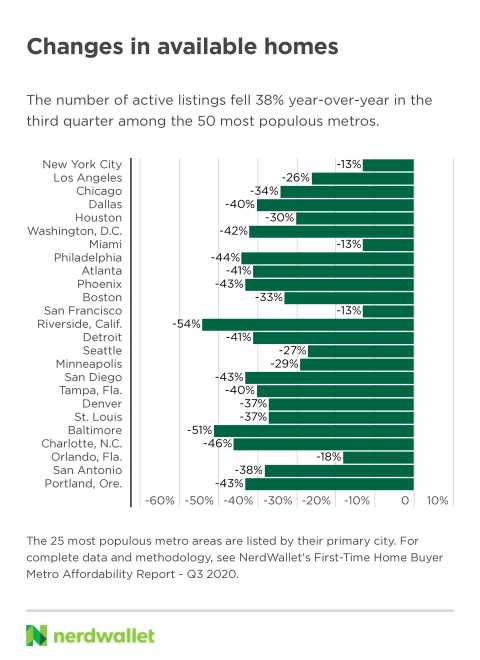First-Time Home Buyer Metro Affordability Report – Q3 2020
Fierce competition for a small pool of listings made home shopping challenging in the third quarter, especially for first-time buyers.

Some or all of the mortgage lenders featured on our site are advertising partners of NerdWallet, but this does not influence our evaluations, lender star ratings or the order in which lenders are listed on the page. Our opinions are our own. Here is a list of our partners.
2020 will go down in history for many things, but one thing it won’t be recognized for: being the easiest year to buy a first home.
This year’s super-low mortgage rates have been enticing enough to persuade well-qualified, experienced buyers to brave a highly competitive housing market, even in the midst of a pandemic. But for many first-time home buyers — who typically have less of a credit track record, smaller down payments and less flexible budgets — the third quarter of this year likely looked particularly daunting.
Mortgage rates have been low and going lower all year, which has helped keep the U.S. homebuying market afloat amid global economic uncertainty. But not everyone can qualify for them, and bargain rates don’t do shoppers much good when there aren’t enough homes to buy.
In NerdWallet’s third quarterly report analyzing affordability for first-time buyers, there was no relief for those trying to squeeze into a market that continues to be characterized by unusually low inventory and ongoing unaffordability. Across the 50 most populous metro areas, the paltry number of homes hitting the market meant sellers could continue to price high in the third quarter, with no cooling-off period in sight.

‘3X income’ guideline still eludes first-timers
Finding a home listed at three times their income — a long-standing gauge of home affordability — proved difficult once again for first-time buyers in the third quarter. Continuing the second-quarter trend, in the most populous metro areas, median list prices remained about 5.2 times first-time home buyer income in July through September.
Though 36% of home purchases in April were made by first-time buyers, that fell to a more typical 31% in September, according to the National Association of Realtors.
Click here for the Q2 2020 First-Time Home Buyer Metro Affordability Report
Though homes became more expensive across nearly all of the most populous metropolitan areas, those locales deemed the most affordable in the second quarter topped the list again: Pittsburgh, the most affordable, where homes were typically listed at 3.3 times median first-time home buyer income in the third quarter, followed by St. Louis (3.3), Buffalo, New York (3.6), Hartford, Connecticut (3.6) and Cleveland (3.7).
Likewise, five metros in California remained the areas most out of reach for first-timers: Los Angeles, where homes were 12.1 times the median first-time buyer income, followed by San Diego (8.6), San Jose (7.9), San Francisco (7.4) and Sacramento (6.8).
Click here for a table containing affordability data for all 50 metros analyzed.
First-time home buyer guidance: Mortgages are more difficult to get this year, as lenders are approving only the most qualified applicants. However, first-time buyers may still have a way in if they’re lucky enough to find a home they love that’s in their budget. First-time home buyer programs, including home loans with more forgivable standards and down payment assistance programs, are still available.
Prices continue rising in third quarter
On average, list prices rose 3% quarter-over-quarter and 7% from last year at this time. Sellers generally list homes higher when the market heats up in spring and summer months. But home prices rose later than usual this year, due to the pandemic hitting right when traditional “homebuying season” would be getting underway.
Prices rose in 41 of the 50 metros analyzed, quarter-over-quarter, climbing the most in Philadelphia and Pittsburgh, where prices were 9% higher than in the second quarter.
In year-over-year changes, homes were listed 23% higher in Pittsburgh in the third quarter of 2020, though the area remains one of the most affordable for first-time buyers. List prices were up from last year in all but two metro areas analyzed — Miami and Orlando, Florida, where homes were listed just 1% less than the third quarter of 2019, after adjusting for inflation.
First-time buyer guidance: Broadly speaking, home prices are rising faster than incomes (and have been for quite some time), so buyers early in their careers may find that what constitutes a “starter home” is increasingly out of reach, particularly in large metro areas. People in fields where they may be able to work remotely even after the pandemic subsides might have better luck looking outside of commuting distance or even in a different metro entirely.
Finding a home even harder in Q3
Not only are the homes available often listed at higher prices than many first-time buyers can stretch to spend, there are very few options available at all. Active listings in the most populous metros were down 38% in the third quarter compared with last year at this time, and down 13% from last quarter.
Five metros saw list counts fall more than 50% from the third quarter of 2019 — 57% in Salt Lake City; 54% in Riverside, California; 53% in Indianapolis; and 51% in Baltimore and Providence, Rhode Island.
Just how this looks to buyers browsing real estate apps: Those who were used to seeing more than 9,230 homes on the market in any given month of the third quarter of 2019 in Denver, for example, are now seeing 5,860 this year (-37%). In Kansas City, the average monthly active listings fell from 6,750 to 3,500 (-48%). And in Riverside, California, home shoppers are seeing roughly 7,230 when they were seeing 15,670 (-54%) last year at this time.
Ordinarily, inventory across the country would begin a seasonal decline in October. But this year never saw the typical spring and summer influx of listings, and fewer and fewer homes are hitting the market as the year goes on.
Nationally, active listings fell 2% in the second quarter, and 14% in the third. Among the largest metros, supply fell 13% quarter-over-quarter.
First-time buyer guidance: The chances of your dream first home coming onto the market are slimmer in 2020, so if finding “the one” is a priority over finding one-that-will-do, consider waiting out the scarcity. Sellers are listing homes at higher prices, and stiff competition among buyers means they’re less likely to negotiate. It isn’t clear how long supply will be this thin, so be aware that waiting to buy could mean waiting until next year or beyond. But with extra time to save, you’ll be going to market with a healthier down payment and potentially bigger budget.
Homes on and off the market in a blink
Sellers are having a heyday, and their homes are moving quickly from newly listed to sold. Metro area homes in the third quarter spent roughly six days less on the market than they did one year ago, and eight days less than in the second quarter.
Average days-on-market fell from 52 in the third quarter of 2019 to 46 this year’s third quarter among the largest metros. And a similar acceleration was seen nationally, where days-on-market fell from 62 to 56 year-over-year.
First-time buyer guidance: Home shoppers need to be ready when they spot a new listing they like. It isn’t unusual for new listings to have multiple offers within a matter of hours in the most competitive markets. Working with a real estate agent who knows the local market is especially valuable when buyers are facing stiff competition — agents may even get tipped off to homes before they hit the MLS, which means you stand to be one of the first offers written if you decide to take the plunge.
METHODOLOGY
Monthly median list price and list count figures are from monthly Inventory Data from the Realtor.com residential listings database as of September 2020. The nominal list prices were adjusted to September 2020 dollars using the U.S. Bureau of Labor Statistics’ Consumer Price Index. All monthly median figures were compiled into quarterly averages.
When comparing new quarterly data with affordability data in the previous quarter, we used figures adjusted to the period in which they were first analyzed. For example, first-quarter list prices and incomes were not adjusted to Q3 dollars when comparing quarter-over-quarter changes. This was done for consistency’s sake between the previous report and the current one.
The median age of first-time home buyers is 33, according to the National Association of Realtors’ 2020 Profile of Home Buyers and Sellers. Estimated income for first-time home buyers was derived from the U.S. Census Bureau’s 2019 American Community Survey median household income for householders ages 25-44 — the range likely to include most first-time home buyers — and escalated to September 2020 dollars using the Bureau of Labor Statistics’ Employment Cost Index.
This quarter the 50 metros selected were updated to reflect the latest (2019) income estimates from the U.S. Census Bureau. Interpret quarter-over-quarter changes in affordability ratios with caution, as changes in income could be due to newer, potentially more precise income estimates.
San Juan, Puerto Rico, is among the 50 most populous metros but was excluded from the analysis due to insufficient inventory data.
Interpret metro rankings with caution. Due to margins of error in income data and rounding, there may be overlap in affordability ratios.


